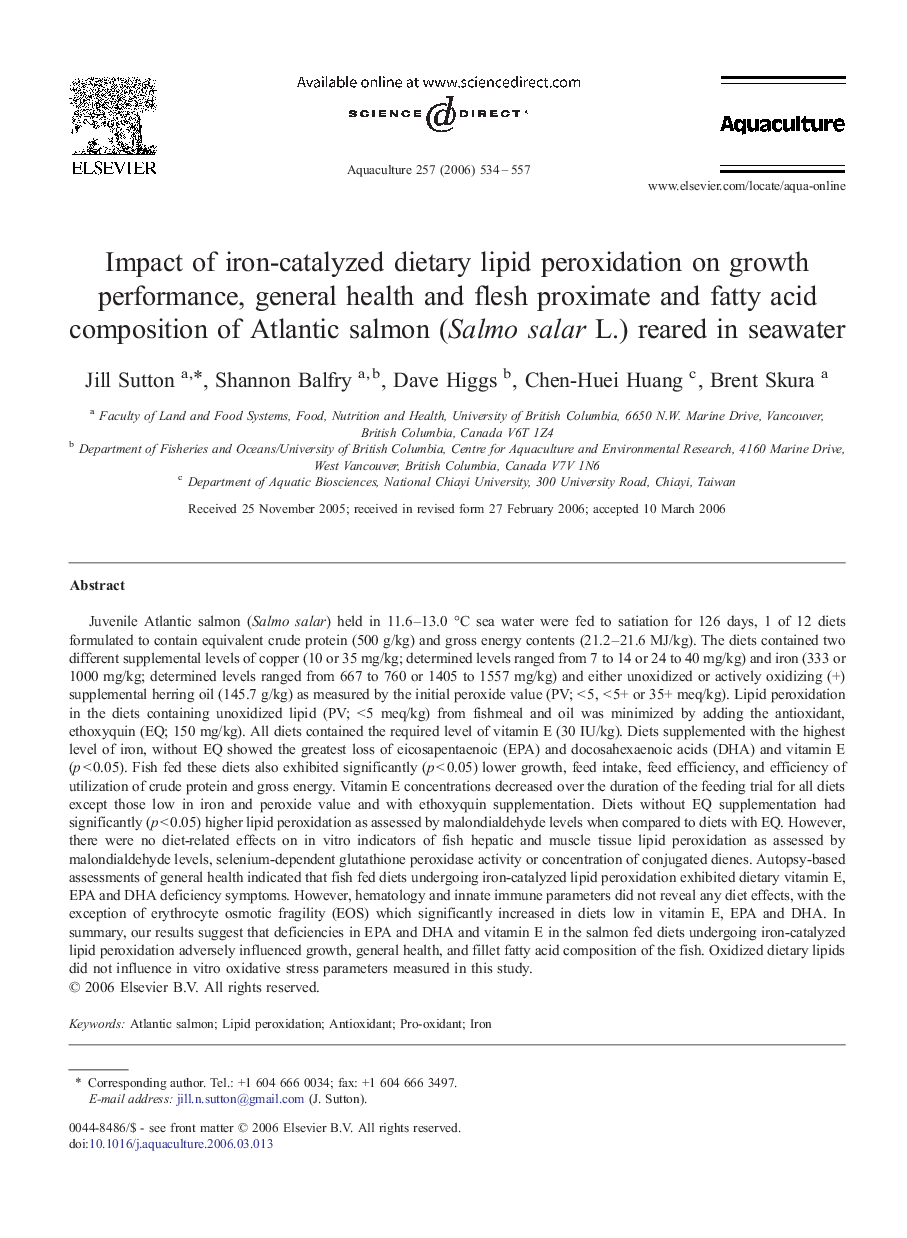| کد مقاله | کد نشریه | سال انتشار | مقاله انگلیسی | نسخه تمام متن |
|---|---|---|---|---|
| 8496889 | 1552984 | 2006 | 24 صفحه PDF | دانلود رایگان |
عنوان انگلیسی مقاله ISI
Impact of iron-catalyzed dietary lipid peroxidation on growth performance, general health and flesh proximate and fatty acid composition of Atlantic salmon (Salmo salar L.) reared in seawater
دانلود مقاله + سفارش ترجمه
دانلود مقاله ISI انگلیسی
رایگان برای ایرانیان
کلمات کلیدی
موضوعات مرتبط
علوم زیستی و بیوفناوری
علوم کشاورزی و بیولوژیک
علوم آبزیان
پیش نمایش صفحه اول مقاله

چکیده انگلیسی
Juvenile Atlantic salmon (Salmo salar) held in 11.6-13.0 °C sea water were fed to satiation for 126 days, 1 of 12 diets formulated to contain equivalent crude protein (500 g/kg) and gross energy contents (21.2-21.6 MJ/kg). The diets contained two different supplemental levels of copper (10 or 35 mg/kg; determined levels ranged from 7 to 14 or 24 to 40 mg/kg) and iron (333 or 1000 mg/kg; determined levels ranged from 667 to 760 or 1405 to 1557 mg/kg) and either unoxidized or actively oxidizing (+) supplemental herring oil (145.7 g/kg) as measured by the initial peroxide value (PV; < 5, < 5+ or 35+ meq/kg). Lipid peroxidation in the diets containing unoxidized lipid (PV; < 5 meq/kg) from fishmeal and oil was minimized by adding the antioxidant, ethoxyquin (EQ; 150 mg/kg). All diets contained the required level of vitamin E (30 IU/kg). Diets supplemented with the highest level of iron, without EQ showed the greatest loss of eicosapentaenoic (EPA) and docosahexaenoic acids (DHA) and vitamin E (p < 0.05). Fish fed these diets also exhibited significantly (p < 0.05) lower growth, feed intake, feed efficiency, and efficiency of utilization of crude protein and gross energy. Vitamin E concentrations decreased over the duration of the feeding trial for all diets except those low in iron and peroxide value and with ethoxyquin supplementation. Diets without EQ supplementation had significantly (p < 0.05) higher lipid peroxidation as assessed by malondialdehyde levels when compared to diets with EQ. However, there were no diet-related effects on in vitro indicators of fish hepatic and muscle tissue lipid peroxidation as assessed by malondialdehyde levels, selenium-dependent glutathione peroxidase activity or concentration of conjugated dienes. Autopsy-based assessments of general health indicated that fish fed diets undergoing iron-catalyzed lipid peroxidation exhibited dietary vitamin E, EPA and DHA deficiency symptoms. However, hematology and innate immune parameters did not reveal any diet effects, with the exception of erythrocyte osmotic fragility (EOS) which significantly increased in diets low in vitamin E, EPA and DHA. In summary, our results suggest that deficiencies in EPA and DHA and vitamin E in the salmon fed diets undergoing iron-catalyzed lipid peroxidation adversely influenced growth, general health, and fillet fatty acid composition of the fish. Oxidized dietary lipids did not influence in vitro oxidative stress parameters measured in this study.
ناشر
Database: Elsevier - ScienceDirect (ساینس دایرکت)
Journal: Aquaculture - Volume 257, Issues 1â4, 30 June 2006, Pages 534-557
Journal: Aquaculture - Volume 257, Issues 1â4, 30 June 2006, Pages 534-557
نویسندگان
Jill Sutton, Shannon Balfry, Dave Higgs, Chen-Huei Huang, Brent Skura,